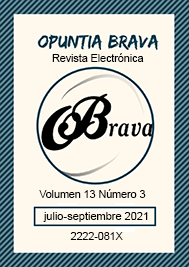Study of the effect of vegetable oils in the control of weevils (Callosobruchus maculatus f) in the preservation of cowpea beans
Keywords:
Callosobruchus maculatus (F), vegetable oils, cowpea bean.Abstract
The weevil (Callosobruchus maculatus F) causes serious damage to cowpea beans, which prevents their use both as food and as seed, and forces the use of toxic or energy-intensive measures for their conservation. The present study aims to protect cowpea beans for seed by means of an economical and environmentally friendly alternative. For this purpose, the preservative effect of three different vegetable oils (Neem, soybean and botija pine nut) was evaluated at a dose of 50 mL/kg of seed. The experiments lasted one month and were carried out at room temperature (32±1 oC), in the facilities of the Grain Department of the UEICA (Agricultural Extension and Training Unit of Holguín). The INIFAT-2002 variety was used, and a randomized complete block design with three treatments and a control (without oil) was used, with four replicates. As a sample, 100 g of grains were used for each experimental unit, which were inoculated with 10 adult insects. The percentages of infection and germination of the grains were evaluated. The three vegetable oils evaluated had a positive effect on the preservation of cowpea beans, maintaining the degree of infestation below 6%, which contrasts with the control, which ended up with all the beans affected. The germination percentage found for the different treatments at the end of the experiment was: Piñón botija (94.5 %), Neem (82.0 %), soybean (76.0 %) and the control (0%).
Downloads
References
Adebowale, K. y Adedire, C. (2006). Chemical Composition and Insecticidal Properties of the Underutilized Jatropha curcas Seed Oil. African Journal of Biotechnology, 5, 901-906. Suth African.
Aspromor, (2012). Plan de desarrollo económico de la provincia de Morropón. Distritos de Morropón 2018-2022. Santa Catalina de Mossa, Buenos Aires, Salitral y San Bigote. Recuperado de http://www.aspromorperu.org/documentos/capacitacionmanejoagronomicofrijol.pdf
Cardona, C., Jarma, A. y Araméndiz, H. (2013). Mecanismos de adaptación a sequía en caupí (Vigna unguiculata (L.) Walp.). Una revisión. Revista colombiana de ciencias hortícolas, 7(2), 277-288, Colombia.
Davidson, J., Dibble, M., Flint, P., Marere, A. y Guye. (1991). Managing insects anf mites with spray oils. IPM Education and Publication. Journal Division of Agriculture and Natural Resources, 3347, 47, USA.
Kusi, F. y Boateng, B. (2008). Toxicity of Jatropha Seed Oil to Callosobruchus maculatus
(Coleoptera: Bruchidae) and its Parasitoid, Dinarmus basalis (Hymenoptera:
Pteromalidae). Department of Crop Science, College of Agriculture and Consumer Sciences, P.O. Box LG44. University of Ghana, Legon, Accra, Ghana.
Pavela, R., Kazda. J. y Herda, G. (2009). Effectiveness of Neem (Azadirachta indica) insecticides against Brassica pod midge (Dasineura brassicae Winn.). Journal of Pest Science, 82, 235-240. México.
Pérez, N. Y. y Vázquez, L. L. (2001). Manejo ecológico de plagas. Transformando el campo cubano. Avances de la Agricultura Sostenible. La Habana: ACTAF.
Salas, J. (1985). Protección de semillas de maíz (Zea mays) contra el ataque de Sitophilus orizaea través del uso de aceites vegetales. Agronomía tropical, 35(4-6), 19-27.
Sousa, A. H., Faroni, L. R., Guedes, N. C., Tótola, M. R. y Urruchi, W. I. (2008). Ozone as a management alternative against phosphine-resistant insect pests of stored products. Journal of Stored Products Research, 44(4), 379-385.
Tshoyhote, N., Nesamvuni, A., Raphulu, T. y Gous, R. (2003). The chemical composition, energy and amino acid diges-tibility of cowpeas used in poultry nutrition. South African. J. Anim Sci. 33, 65-69.






















